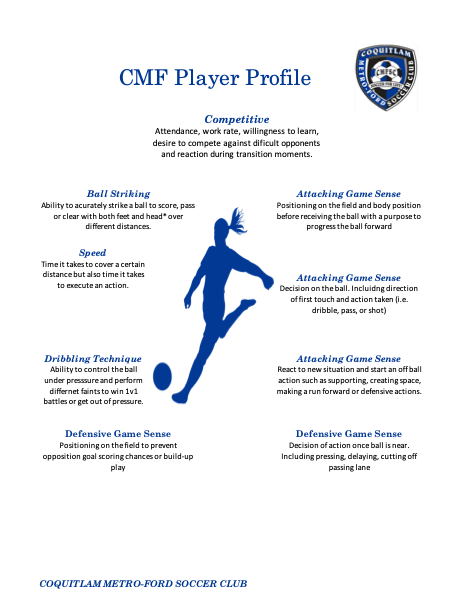Player Selection
Player Selection
CMFSC technical staff aims to make player selections based on the best interests of individuals, prioritizing their success and enjoyment of the game, with a focus on long-term participation.
It is important for parents and players to understand that all selections are circumstantial, and a player's success at a certain level depends entirely on the players within their age group.
Four main categories are considered when making selections and these are monitored in both training and game settings.
- Competitiveness: This includes attendance, work rate, willingness to learn, desire to compete against tough opponents, and efforts to acquire difficult skills.
- Ball Striking: The ability to accurately pass and shoot with both the dominant and non-dominant leg during game situations.
- Speed: The time it takes to cover a certain distance. Speed is beneficial for defensive actions such as pressing, recovering, as well as attacking options such as 1v1 situations or running behind the defense.
- Dribbling Ability: The ability to control the ball under pressure and execute various feints to win 1v1 battles or escape pressure.
- Game Sense: Ability to choose appropriate positioning and actions during different game situations to give the best possible chance for a team to succeed.
Depending on the age group's level, players will find success with a combination of these.
For example:
- Player A is more competitive and faster than their teammates may perform well at higher levels based on their work rate and speed alone, while they continue to develop technical skills. However, if the group at the higher level is equally as fast but more technically proficient, Player A may not find enough success and may be better placed at a lower level to work on their technical ability.
- Player B is more technically skilled with good ball striking and dribbling abilities but lacks speed, player B may excel at a higher level if their technical skills are above average. However, they may struggle with the pace of the game if their technical ability is not much higher than their teammates.
We encourage families to look at their current level of play as a steppingstone for the future. The path of development is not set and can be different for every player – our goal is always to provide each player with a positive experience no matter what level they are at. Many of our Club top players were late bloomers who excelled by playing at lower levels to develop a love for the process rather than focusing solely on outcomes. This passion for the game leads to more free play and extra practice, naturally resulting in success and unmatched competitiveness at higher levels.

